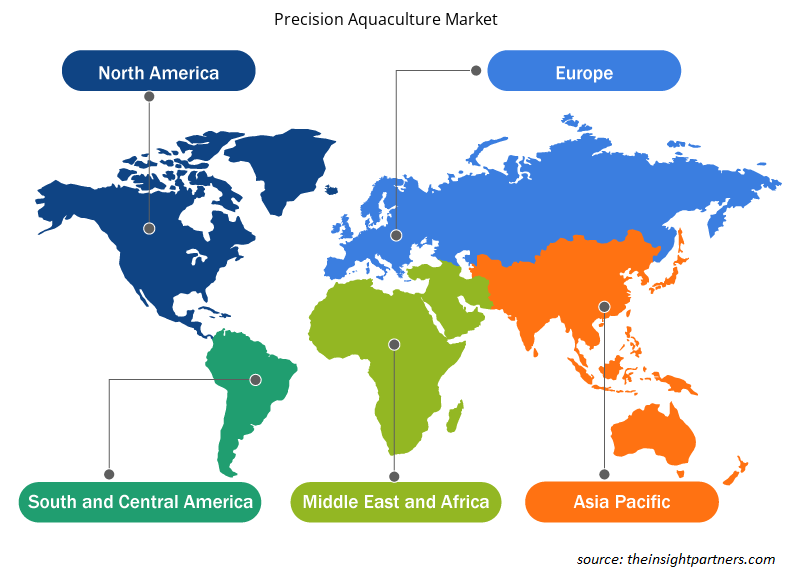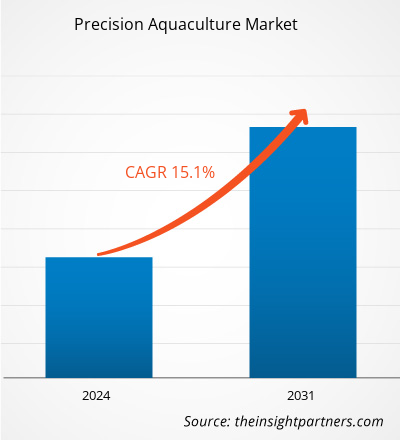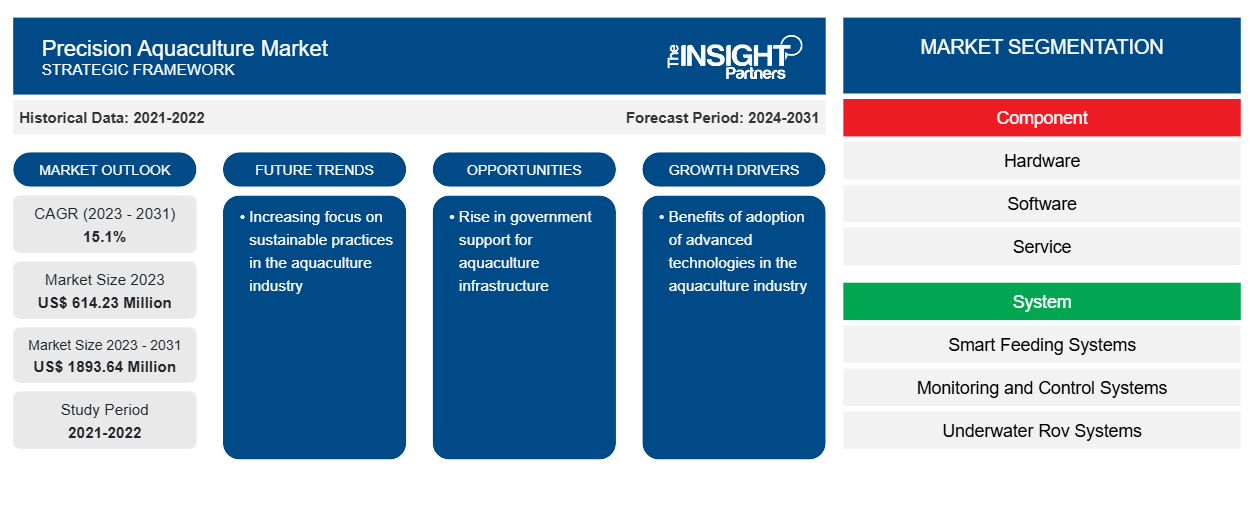Se proyecta que el tamaño del mercado de la acuicultura de precisión alcance los 1.893,64 millones de dólares estadounidenses en 2031, frente a los 614,23 millones de dólares estadounidenses en 2023. Se espera que el mercado registre una CAGR del 15,1 % durante el período 2023-2031. Es probable que el aumento de la inversión en infraestructura para la acuicultura y la creciente adopción de soluciones de IoT en la industria de la acuicultura sigan siendo tendencias clave en el mercado.
Análisis del mercado de la acuicultura de precisión
El aumento de la adopción de IA, IoT y ROV en la acuicultura es uno de los principales factores que impulsan el crecimiento del mercado. El creciente enfoque y la inversión del gobierno en el desarrollo de infraestructura acuícola impulsan el crecimiento del mercado. La contribución de las técnicas de acuicultura de precisión a la producción sostenible de productos del mar y la satisfacción de la demanda mundial de productos acuáticos impulsa aún más el crecimiento del mercado.
Descripción general del mercado de acuicultura de precisión
La industria de la acuicultura está experimentando ampliamente la implementación de dispositivos de Internet de las cosas (IoT) para modernizar sus granjas y tomar decisiones basadas en datos. La acuicultura de precisión utiliza sensores y software interconectados en el entorno marino para monitorear, analizar, interpretar y brindar apoyo para la toma de decisiones en las operaciones de las granjas acuícolas. El sistema de acuicultura basado en datos ayuda a los operadores de la industria acuícola a aumentar la productividad.
Personalice este informe según sus necesidades
Obtendrá personalización en cualquier informe, sin cargo, incluidas partes de este informe o análisis a nivel de país, paquete de datos de Excel, así como también grandes ofertas y descuentos para empresas emergentes y universidades.
- Obtenga las principales tendencias clave del mercado de este informe.Esta muestra GRATUITA incluirá análisis de datos, desde tendencias del mercado hasta estimaciones y pronósticos.
Factores impulsores y oportunidades del mercado de la acuicultura de precisión
Beneficios de la Adopción de Tecnologías Avanzadas en la Industria Acuícola para Favorecer el Mercado
La industria de la acuicultura enfrenta desafíos como el aumento de los costos de los alimentos y la energía, las amenazas ambientales, las ineficiencias de producción y otros. Para superar estos desafíos, la industria está utilizando sensores, cámaras, inteligencia artificial, tecnologías en la nube y varias otras soluciones para obtener información sin precedentes basada en los datos, lo que conduce al crecimiento del mercado de la acuicultura de precisión. Además, los actores del mercado están brindando soluciones a los actores del mercado de la industria de la acuicultura. Por ejemplo, las tecnologías de acuicultura de precisión de Innovasea ayudan a los operadores de acuicultura a monitorear, administrar y controlar de cerca sus operaciones basándose en datos confiables en tiempo real. Ayuda a los operadores a tomar mejores decisiones para aumentar las ganancias y ser más sostenibles.Innovasea’s precision aquaculture technologies help aquaculture operators to closely monitor, manage and control their operations based on reliable real-time data. It helps the operators with better decision-making to boost profits and become more sustainable.
Aumenta el apoyo gubernamental a la infraestructura de acuicultura
La creciente tendencia hacia la pesca inteligente y el crecimiento del comercio de productos del mar están aumentando la demanda de productos necesarios para el desarrollo de la infraestructura de la acuicultura. Los cambios en los patrones de consumo de alimentos en todo el mundo también están contribuyendo a la expansión y diversificación de esta industria. Además, el crecimiento de la industria minorista y la fácil disponibilidad de productos de acuicultura a través de numerosos canales impulsan las ventas de estos productos. El crecimiento vigoroso y continuo de la acuicultura en varios países importantes, como Noruega, China, India e Indonesia, está impulsando el mercado mundial de la acuicultura de precisión.
Análisis de segmentación del informe de mercado de acuicultura de precisión
Los segmentos clave que contribuyeron a la derivación del análisis del mercado de acuicultura de precisión son el componente, el sistema y la aplicación.
- Según los componentes, el mercado de la acuicultura de precisión se divide en hardware, software y servicios. El segmento de hardware tuvo la mayor participación del mercado en 2023.
- Por sistema, el mercado se segmenta en sistemas de alimentación inteligente , sistemas de monitoreo y control, sistemas submarinos ROV y otros. Los sistemas de alimentación inteligente ocuparon una participación significativa del mercado en 2023.Rov systems, and others. The smart feeding systems held a significant share of the market in 2023.
- Por aplicación, el mercado está segmentado en detección y prevención de fraudes, gobernanza, riesgo y cumplimiento (GRC), gestión de la experiencia del cliente, mantenimiento predictivo, gestión de la cadena de suministro, inteligencia de amenazas y otros. La gestión de la experiencia del cliente ocupó una participación significativa del mercado en 2023.GRC), customer experience management, predictive maintenance, supply chain management, threat intelligence, and others. The customer experience management held a significant share of the market in 2023.
Análisis de la cuota de mercado de la acuicultura de precisión por geografía
El alcance geográfico del informe del mercado de acuicultura de precisión se divide principalmente en cinco regiones: América del Norte, Asia Pacífico, Europa, Medio Oriente y África, y América del Sur y Central.
Se espera que Europa mantenga una CAGR significativa en el período de pronóstico. El aumento de la digitalización y la creciente demanda de técnicas avanzadas de análisis de datos en la región están impulsando el crecimiento del mercado. Además, el fondo gubernamental para impulsar la industria de la acuicultura impulsa el mercado. Por ejemplo, el Fondo Horizonte 2020 de la UE tenía como objetivo la intensificación sostenible de la acuicultura en Europa. El proyecto GAIN financiado por el Fondo Horizonte 2020 de la UE se centra en la acuicultura de precisión.CAGR in the forecast period. The rise in digitalization and growing demand for advanced data analytics techniques in the region is driving market growth. In addition, the government fund to fuel the aquaculture industry drives the market. For example, the EU Horizon 2020 Fund aimed at sustainable aquaculture intensification in Europe. The GAIN project funded by the EU Horizon 2020 Fund is focused on precision aquaculture.
Perspectivas regionales del mercado de acuicultura de precisión
Los analistas de Insight Partners explicaron en detalle las tendencias y los factores regionales que influyen en el mercado de acuicultura de precisión durante el período de pronóstico. Esta sección también analiza los segmentos y la geografía del mercado de acuicultura de precisión en América del Norte, Europa, Asia Pacífico, Oriente Medio y África, y América del Sur y Central.

- Obtenga datos regionales específicos para el mercado de acuicultura de precisión
Alcance del informe sobre el mercado de acuicultura de precisión
| Atributo del informe | Detalles |
|---|---|
| Tamaño del mercado en 2023 | US$ 614,23 millones |
| Tamaño del mercado en 2031 | US$ 1893,64 millones |
| CAGR global (2023 - 2031) | 15,1% |
| Datos históricos | 2021-2022 |
| Período de pronóstico | 2024-2031 |
| Segmentos cubiertos | Por componente
|
| Regiones y países cubiertos | América del norte
|
| Líderes del mercado y perfiles de empresas clave |
|
Densidad de actores del mercado de acuicultura de precisión: comprensión de su impacto en la dinámica empresarial
El mercado de la acuicultura de precisión está creciendo rápidamente, impulsado por la creciente demanda de los usuarios finales debido a factores como la evolución de las preferencias de los consumidores, los avances tecnológicos y una mayor conciencia de los beneficios del producto. A medida que aumenta la demanda, las empresas amplían sus ofertas, innovan para satisfacer las necesidades de los consumidores y aprovechan las tendencias emergentes, lo que impulsa aún más el crecimiento del mercado.
La densidad de actores del mercado se refiere a la distribución de las empresas o firmas que operan dentro de un mercado o industria en particular. Indica cuántos competidores (actores del mercado) están presentes en un espacio de mercado determinado en relación con su tamaño o valor total de mercado.
Las principales empresas que operan en el mercado de acuicultura de precisión son:
- GRUPO AKVA
- Escala AQ
- CHETU INC
- Caminante profundo
- SISTEMAS INNOVASEA
- Pentair AES
Descargo de responsabilidad : Las empresas enumeradas anteriormente no están clasificadas en ningún orden particular.

- Obtenga una descripción general de los principales actores clave del mercado de acuicultura de precisión
Noticias y desarrollos recientes del mercado de acuicultura de precisión
El mercado de la acuicultura de precisión se evalúa mediante la recopilación de datos cualitativos y cuantitativos a partir de investigaciones primarias y secundarias, que incluyen importantes publicaciones corporativas, datos de asociaciones y bases de datos. A continuación, se enumeran algunos de los avances en el mercado de la acuicultura de precisión:
- Innovasea, líder mundial en soluciones acuáticas tecnológicamente avanzadas para la acuicultura y el rastreo de peces, anunció que ahora ofrece soluciones de acuicultura terrestre a la industria acuícola chilena. (Fuente: Innovasea, Comunicado de Prensa, Abril 2024)
- Skretting Southern Europe ha lanzado 360+, el innovador concepto de agricultura de precisión que optimiza los protocolos de alimentación y la gestión de la producción, aumentando aún más la competitividad de la acuicultura mediterránea. Utilizando el software analítico más reciente y otras tecnologías de la Industria 4.0 para aportar mayores niveles de innovación a la producción pesquera, Skretting 360+ es un paquete completo de herramientas y servicios basados en la precisión que incorpora nutrición, prácticas de gestión de granjas y soporte técnico, así como cámaras submarinas y equipos de sensores de última generación (IoT). (Fuente: Skretting, nota de prensa, abril de 2023)
Informe sobre el mercado de acuicultura de precisión: cobertura y resultados
El informe “Tamaño y pronóstico del mercado de acuicultura de precisión (2021-2031)” proporciona un análisis detallado del mercado que cubre las siguientes áreas:
- Tamaño del mercado de acuicultura de precisión y pronóstico a nivel mundial, regional y nacional para todos los segmentos clave del mercado cubiertos bajo el alcance
- Tendencias del mercado de acuicultura de precisión, así como dinámicas del mercado, como impulsores, restricciones y oportunidades clave
- Análisis detallado de las cinco fuerzas de Porter y PEST y FODA
- Análisis del mercado de acuicultura de precisión que abarca las tendencias clave del mercado, el marco global y regional, los principales actores, las regulaciones y los desarrollos recientes del mercado.
- Análisis del panorama de la industria y de la competencia que abarca la concentración del mercado, el análisis de mapas de calor, los actores destacados y los desarrollos recientes para el mercado de la acuicultura de precisión
- Perfiles detallados de empresas
- Análisis histórico (2 años), año base, pronóstico (7 años) con CAGR
- Análisis PEST y FODA
- Tamaño del mercado, valor/volumen: global, regional y nacional
- Industria y panorama competitivo
- Conjunto de datos de Excel
Informes recientes
Testimonios
Razón para comprar
- Toma de decisiones informada
- Comprensión de la dinámica del mercado
- Análisis competitivo
- Información sobre clientes
- Pronósticos del mercado
- Mitigación de riesgos
- Planificación estratégica
- Justificación de la inversión
- Identificación de mercados emergentes
- Mejora de las estrategias de marketing
- Impulso de la eficiencia operativa
- Alineación con las tendencias regulatorias





















 Obtenga una muestra gratuita para - Mercado de acuicultura de precisión
Obtenga una muestra gratuita para - Mercado de acuicultura de precisión